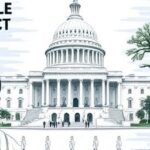Washington, DC – With just weeks remaining before enhanced Affordable Care Act subsidies expire at the end of the year, Congress remains deadlocked in a partisan standoff, putting affordable health insurance out of reach for up to 16 million Americans. Premiums could skyrocket by an average of 75% or more for many enrollees, according to estimates from the Congressional Budget Office (CBO), potentially triggering a surge in the uninsured rate not seen since before the ACA’s implementation.
- 16 Million Enrollees Hang in the Balance Amid Subsidy Expiration
- Partisan Battle Lines Drawn Over ACA Subsidies in Congress
- Failed Year-End Push Exposes Cracks in Bipartisan Health Policy Efforts
- Families and Providers Brace for Premium Shockwaves Across America
- Pathways to Resolution or Prolonged Uncertainty in ACA’s Future
The stalemate centers on the temporary subsidies, bolstered by the 2021 American Rescue Plan Act, which have driven record enrollment in ACA marketplaces. Without extension, low- and middle-income families face a harsh fiscal cliff, exacerbating ongoing debates over health policy in a divided Congress.
16 Million Enrollees Hang in the Balance Amid Subsidy Expiration
The enhanced subsidies under the Affordable Care Act have been a lifeline for millions, capping premiums at 8.5% of household income for those earning up to 400% of the federal poverty level—far more generous than the original ACA caps. Centers for Medicare & Medicaid Services (CMS) data shows a staggering 16 million people enrolled in ACA marketplace plans during the 2024 open enrollment period, a 25% increase from pre-pandemic levels, largely attributed to these subsidies.
Without renewal, the CBO projects that 4 million could drop coverage entirely by mid-2025, while others might shift to employer plans or Medicaid where available. “These subsidies aren’t just numbers on a spreadsheet; they’re preventing medical bankruptcies and keeping families healthy,” said Dr. Elena Ramirez, health policy director at the Kaiser Family Foundation (KFF). In states like West Virginia and Kentucky, where rural hospitals already struggle, expiration could lead to clinic closures and emergency room overloads.
- Enrollment Surge: ACA plans hit 21 million total including Medicaid expansions, per CMS November 2024 report.
- Cost Savings: Average annual premium reduction of $800 per enrollee due to subsidies.
- High-Risk States: Florida, Texas, and Georgia lead in potential coverage losses, with over 3 million affected combined.
Health insurance experts warn that marketplace instability could ripple through the individual market, raising rates for everyone as healthier individuals exit.
Partisan Battle Lines Drawn Over ACA Subsidies in Congress
Republicans, led by House Speaker Mike Johnson, demand reforms tying any extension to measures like work requirements, drug price negotiations, and caps on illegal immigrant coverage. “We can’t keep pouring billions into a broken system without accountability,” Johnson stated in a recent floor speech. Senate Minority Leader Mitch McConnell echoed this, calling for a “market-based overhaul” to replace what he termed “Obamacare’s fiscal black hole.”
Democrats, holding a slim Senate majority, view the subsidies as non-negotiable pillars of health policy. Senate Majority Leader Chuck Schumer warned, “Letting these expire would be a Republican tax on working families,” during a press conference last week. Progressive voices like Sen. Bernie Sanders push for permanent expansion, arguing it aligns with broader Medicare-for-All goals.
The divide has torpedoed multiple bipartisan talks. A September proposal by Sens. Susan Collins (R-ME) and Jeanne Shaheen (D-NH) for a two-year extension with modest reforms garnered 15 co-sponsors but stalled in committee amid Freedom Caucus opposition.
Failed Year-End Push Exposes Cracks in Bipartisan Health Policy Efforts
October’s lame-duck session preview saw intense negotiations collapse when House Republicans rejected a $100 billion health package that included subsidy extensions alongside farm aid. “We’re inches away but worlds apart on core principles,” confided a senior GOP aide to reporters.
Flashback to 2021: The American Rescue Plan’s subsidy boost was a COVID-era compromise, extended via the 2022 Inflation Reduction Act through 2025. Now, with elections reshaping the House, urgency mounts. Lobbyists from AARP and the American Hospital Association flooded Capitol Hill last week, delivering petitions signed by 500,000 advocating for continuity.
“Congress has the votes if leadership prioritizes people over politics.” – AARP CEO Jo Ann Jenkins
Procedural hurdles loom large: Reconciliation rules could bypass filibusters for budget-related items, but Democrats lack unified support for attaching subsidies to must-pass spending bills.
Families and Providers Brace for Premium Shockwaves Across America
In Ohio, single mother Maria Gonzalez, 38, credits ACA subsidies for her family’s coverage. “My premium dropped from $1,200 to $450 monthly. Without it, we’d be rationing doctor visits,” she shared in a KFF interview. Stories like hers abound: A Texas rancher facing a 90% hike, a Florida retiree weighing part-time work to qualify for aid.
Providers feel the pinch too. The American Medical Association reports 30% of marketplace patients are subsidy-dependent, with non-payment rates potentially doubling post-expiration. Rural health centers in the Midwest anticipate 20% patient drops, per National Rural Health Association data.
- Personal Impacts: 60% of subsidy households are within 200% of poverty line (KFF).
- Market Disruptions: Insurers like UnitedHealth warn of exiting unprofitable states.
- State Responses: California and New York mull state-funded bridges, but red states hesitate.
Economists project a $50 billion hit to GDP from lost productivity and increased uncompensated care by 2026.
Pathways to Resolution or Prolonged Uncertainty in ACA’s Future
As December dawns, eyes turn to a potential December 20 spending bill deadline. Moderates like Rep. Don Bacon (R-NE) float a one-year bridge with sunset clauses, buying time for 2025 Trump-era reforms if Republicans gain ground. Yet, incoming President-elect Donald Trump’s team signals openness to “big changes,” per transition spokespeople, complicating short-term deals.
Health policy analysts at Brookings Institution outline three scenarios: full extension (unlikely), partial reform package (plausible via Collins-Shaheen 2.0), or cliff-dive into 2026 chaos. “States could fill gaps via waivers, but that’s patchwork at best,” noted Brookings fellow Louise Sheiner.
Advocacy ramps up: Planned Parenthood and Blue Cross Blue Shield launched a “Save Our Subsidies” ad blitz targeting swing districts. Meanwhile, CBO updates peg extension costs at $335 billion over a decade—peanuts compared to trillion-dollar defense bills, argue proponents.
Looking ahead, expiration could fuel 2026 midterm narratives, with Democrats framing it as GOP cruelty and Republicans as fiscal responsibility. For now, millions hold breath, hoping Congress prioritizes health insurance stability over gridlock. Negotiations resume Monday, with whispers of a breakthrough—or breakdown—imminent.









